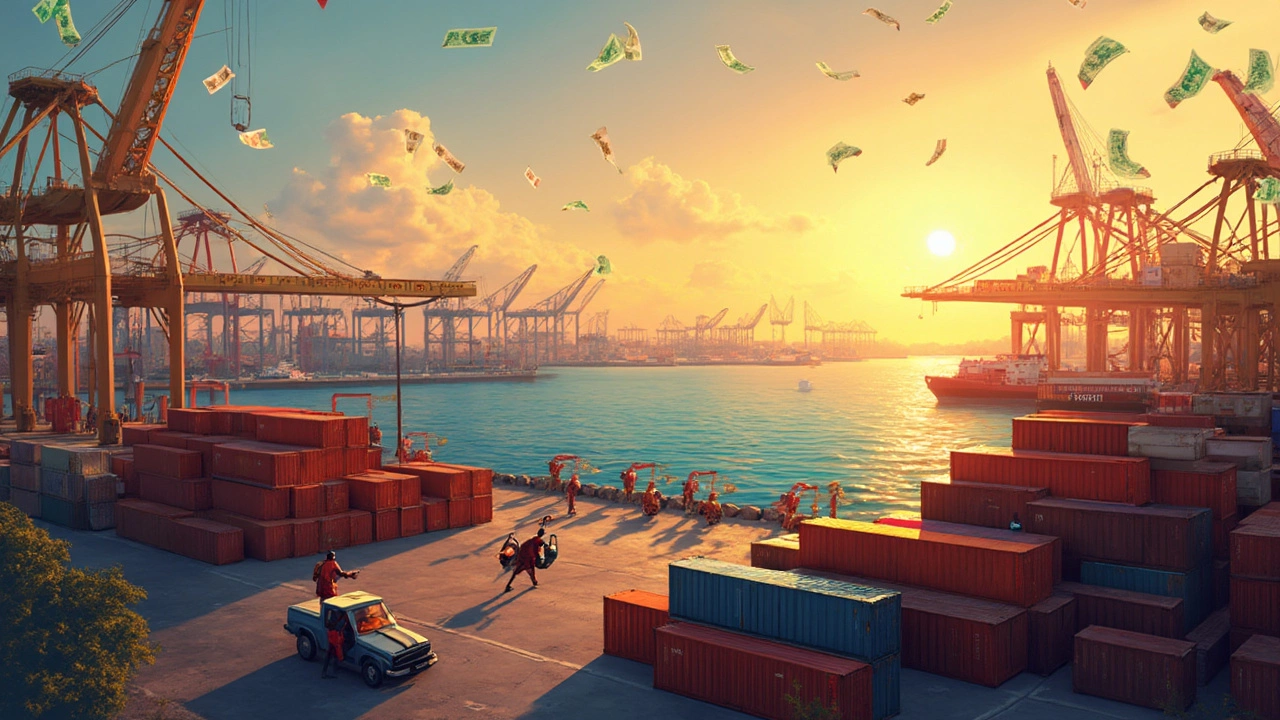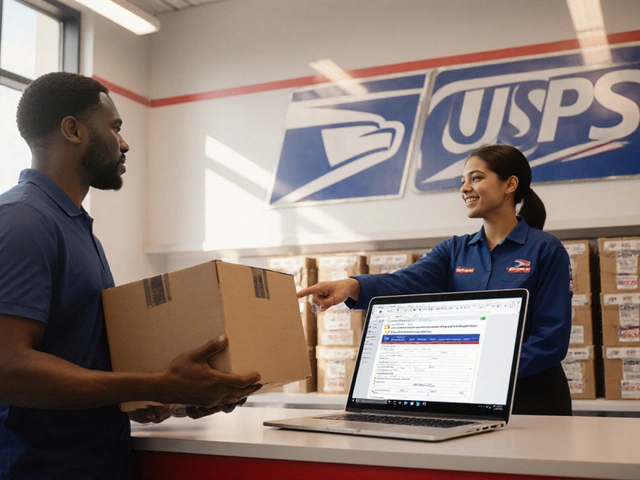Ever felt like you're paying more for shipping than the item itself? You're not alone. International shipping prices can feel painfully high, and there's a good reason for that. Between the logistical gymnastics of moving goods across continents and unavoidable dues like taxes and customs, costs pile up fast.
Distance is a significant factor. It seems simple, right? Ship further, pay more. But it's not just about miles. From air freight charges to how much real estate goods take up on shipping vessels, every aspect adds up. And then there are the tax games. Depending on where your package is coming from or going to, different import duties or VAT can spring out of nowhere, making the final bill look like your worst fear.
Fuel isn't cheap either, and with fluctuating oil prices, carriers often adjust with fuel surcharges. These are additional fees tacked on to cover the price of oil—unexpected and fluctuating, thanks to the unpredictable nature of global markets.
Government regulations can also hide a lot of costs. Everything from safety checks to paperwork piles on more expenses that someone—you—has to pay for.
All this might sound grim, but don't worry. There are nuggets of wisdom and practical tips to help soften the blow on your wallet. So, stay with us as we unravel these shipping mysteries and look for ways you can shave off some hefty price points.
- The Real Cost of Distance
- Tax and Customs Surprises
- Fuel Surcharges and Fees
- Hidden Costs of Regulation
- Tips to Reduce Shipping Costs
The Real Cost of Distance
So, why does shipping from one country to another, or even just across the ocean, feel so steep? The answer's pretty straightforward: distance costs money. But let's break that down a bit.
It's Not Just About Miles
Think of international shipping as a giant web. Every stretch of that web requires resources. Not only are we talking fuel and time, but there's also warehousing, handling, and transportation across different landscapes. Every mode of transport, whether it's planes, ships, or trucks, adds its own set of fees.
And it's not like a simple road trip. Every country has its own rules, requiring different procedures, all of which incur costs. As Mary Moyer, a logistics manager, aptly puts it,
"Shipping internationally isn't just about moving a package from A to B. It's about navigating through a complex maze of regulations and landscapes."
Demand vs. Capacity
When demand for goods spikes but the carrier capacity lags, prices naturally go up. For instance, during holiday seasons or global events, shipping spaces become premium real estate. This dynamic impacts how companies price their logistics services.
Here's an interesting tidbit: The world’s top shipping lanes are congested, and any delay can bump up costs further. That’s why a lot of companies aim to ship early or choose less congested, albeit longer, paths to keep costs stable.
Strategies to Cut Costs
If you’re dealing with regular international shipping, think long-term. Consider consolidating shipments. By combining shipments, businesses can share container space, which lowers costs for everyone involved. Also, try to plan for flexibility. Sometimes, allowing an extra day or two can reduce express shipping fees substantially.
In essence, while distance plays a huge role in the cost puzzle, knowing how to navigate these waters with strategic planning can save you or your business a chunk of change. The more you understand where the costs come from, the better equipped you'll be to tackle them.
Tax and Customs Surprises
So you've found a killer deal on a pair of shoes online, but by the time they reach your doorstep, those savings seem to vanish into thin air. Why? Tax and customs duties are the usual suspects. They are like those sneaky fees that magically appear just when you're about to checkout.
Customs duties are essentially taxes on imports paid to the government. Depending on where you're shipping from, and the category of goods, these can vary wildly. For instance, importing electronics might cost you more in duties compared to clothing. It’s not just about the item type, though. Different countries have different tax thresholds, and it’s this small print that often bites.
VAT vs. Duty
Many countries charge VAT (Value Added Tax) on top of customs duties. What's frustrating is that even shipping costs might be subject to VAT, which means you’re paying a tax on the cost of transporting your item—which already feels high.
Here’s how it often pans out:
- You find something priced at $100.
- Shipping adds $20.
- Import duty might be around 5% of the item’s value ($5).
- VAT at, say, 20% might be applied to both the item and shipping ($24).
You started with a $100 item and suddenly you're at $149. Dif-frustrating, right?
How to Navigate These Costs
The big question: "How can I avoid this?" While it’s hard to escape all taxes, you can certainly minimize them with a few tricks:
- Research before you buy: Some retailers offer Duty Delivery Paid (DDP) options, which mean they cover the customs fees for you. It might cost a bit more upfront, but it stops those nasty surprises.
- Shop locally: Sounds obvious, but buying from retailers based in your country eliminates these extra costs.
- Split your purchases: Instead of buying one big expensive item, see if purchasing smaller, less expensive items separately helps dodge some duties.
In some instances, specific trade agreements might reduce or eliminate duties. It’s worth checking if your country has any such deals with the exporter country. Next time you see those unexpected shipping fees, you’ll know who the culprits are and hopefully, these tips will help keep those costs in check.

Fuel Surcharges and Fees
Let's be real, the price of moving goods internationally comes with some eyebrow-raising charges, and fuel surcharges are one of the biggest culprits. It's no secret that the global shipping economy heavily relies on fossil fuels, and as oil prices swing up and down, so do the costs shippers like you face.
Shipping companies often add these fuel surcharges to your bill to protect themselves against fluctuating oil prices. In fact, companies like DHL and FedEx regularly update their surcharge rates based on global oil markets. Think of it like a tax, but one that's keeping pace with how much it costs to keep those massive vessels and planes moving.
"With oil market volatility, fuel surcharges are a necessary evil to ensure logistical operations continue smoothly across the globe," says David Smith, a logistics analyst at Global Trade Insights.
How Fuel Surcharges Affect You
The direct impact on your shipping costs can vary, but on average, fuel surcharges can add anywhere from 10% to 30% on top of the base shipping rate! It's not a small chunk of change. What's more, these charges aren't always transparent. They can pop up unexpectedly and force you to rethink your shipping budget.
Keeping Track of Surcharges
So how do you stay ahead of these unpredictable costs? Many shipping companies publish their surcharge tables online. It's a good idea to check these before you finalize any long-distance deliveries. Being proactive can save you from sticker shock later.
Negotiating Costs
In some cases, you might have room to negotiate. If you're a frequent shipper or have a solid history with a particular carrier, see if you can get a discount on these surcharges. It never hurts to ask.
Remember, knowledge is power, especially in the world of international shipping. By understanding surcharges and keeping them on your radar, you'll be better equipped to handle those sneaky fees when they come your way.
Hidden Costs of Regulation
Ever wondered about the bureaucracy behind shipping your favorite products internationally? It’s a maze of rules and standards that add sneaky extra bucks to your shipping costs. Every country has its own unique set of regulations when it comes to international shipping, and they aren’t always straightforward.
One of the major regulations affecting international shipping is safety compliance. To ensure that products are safe for consumers, countries require certain certifications and documentation. This isn't just paperwork; sometimes it involves lengthy inspections and tests. These processes require time and logistical coordination, which means more expenses on the shipper’s part.
Customs and Import Duties
Customs duties can be pretty daunting. Depending on the product type and declared value, customs can impose significant fees that become part of the overall shipping cost. For instance, a package might need to go through inspections to check if it complies with local import laws, like food safety standards or electronics certifications. These checks aren't free and can sometimes lead to delays, adding to the cost.
Environmental Regulations
Environmental laws are another layer of complexity. The shipping industry is under pressure to reduce emissions, and this means ship operators may need to invest in cleaner fuels or newer, compliant ships. The cost of these investments can trickle down to what you pay at checkout.
Quarantine and Health Regulations
Remember those banana boxes always getting checked at customs? That’s quarantine regulation at work. Products like plants, animals, and even frozen foods require special handling to prevent the spread of diseases, which leads to extra handling costs. Quarantine compliance ensures safety but can be taxing on your wallet.
While these regulations are important for safety and environmental reasons, they’re a big part of what makes international shipping pricey. The trick is to know what regulations might affect your shipment, plan for delays, and choose shipping methods that minimize these costs.

Tips to Reduce Shipping Costs
Feeling the pinch of those hefty international shipping bills? You're not alone. But there are ways to bring those costs down without sacrificing reliability.
1. Compare Shipping Rates
Don't settle for the first price you see. Different carriers offer varying rates and sometimes it's all about timing— one week's sale can make a big difference. Try using shipping rate comparison tools online to find the best deal.
2. Consolidate Shipments
If you're shipping multiple items overseas, try to bundle them into one package. Not only does this save on packaging, but you'll often get a better deal than paying multiple times. Keep in mind that the weight and dimensions can affect your pricing, so it's a balancing act.
3. Choose the Right Carrier
Not all carriers are created equal, especially when it comes to global logistics. Some specialize in certain regions. Do a bit of research: a carrier might offer better rates to the exact destination you're eyeing.
4. Optimize Package Weight and Size
The size and weight of your package play a major role in cost. Use smaller boxes and avoid excessive packaging. Carriers typically charge more by dimensional weight, so less bulk can lead to more savings.
5. Plan Ahead
Last-minute shipments will always cost you more. If you have a bit of foresight, use it. Expedite services are costly, so whenever possible, stick to standard shipping.
| Carrier | Shipping Cost (Example) |
|---|---|
| DHL | $50 - $100 |
| FedEx | $45 - $95 |
| UPS | $55 - $105 |
These tips won’t make shipping free, but they’re sure to slash that next bill. Even if it's just a little, every penny saved is worth the effort when it comes to shipping prices.





